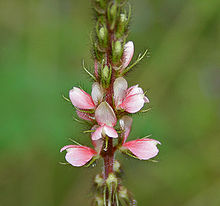| Indigofereae | |
|---|---|

| |
| Indigofera astragalina | |
| Scientific classification | |
| Kingdom: | Plantae |
| Clade: | Tracheophytes |
| Clade: | Angiosperms |
| Clade: | Eudicots |
| Clade: | Rosids |
| Order: | Fabales |
| Family: | Fabaceae |
| Subfamily: | Faboideae |
| Clade: | Meso-Papilionoideae |
| Clade: | Non-protein amino acid-accumulating clade |
| Tribe: | Indigofereae (Benth.) Hutch.[1] |
| Genera | |
|
See text | |
| Synonyms | |
The tribe Indigofereae is a subdivision of the plant family Fabaceae. It is consistently recovered as a monophyletic clade in molecular phylogenies.[5][6][7][8][9][10][11][12][13][14][4][15][16][17][18][19][excessive citations] The Indigofereae arose 30.0 ± 3.3 million years ago (in the Oligocene).[20]
This tribe does not currently have a node-based, phylogenetic definition, but it can be distinguished by the following morphological synapomorphies: the presence of biramous hairs, keel spurs, short free staminal filaments, and short fruiting pedicels; and the loss of stipels and seed arils.[3]
- ^ "Tribe Indigofereae (Benth.) Hutch". Global Plants. JSTOR. Retrieved November 15, 2013.
- ^ Cite error: The named reference
Kew Indigofereaewas invoked but never defined (see the help page). - ^ a b Schrire BD; Lavin M; Barker NP; Forest F (2009). "Phylogeny of the tribe Indigofereae (Leguminosae-Papilionoideae): Geographically structured more in succulent-rich and temperate settings than in grass-rich environments". Am J Bot. 96 (4): 816–52. doi:10.3732/ajb.0800185. PMID 21628237.
- ^ a b Cardoso D; de Queiroz LP; Pennington RT; de Lima HC; Fonty É; Wojciechowski MF; Lavin M (2012). "Revisiting the phylogeny of papilionoid legumes: new insights from comprehensively sampled early-branching lineages". Am J Bot. 99 (12): 1991–2013. doi:10.3732/ajb.1200380. PMID 23221500.
- ^ Barker NP; Schrire BD; Kim J-H (2000). "Generic relationships in the tribe Indigofereae (Leguminosae: Papilionoideae) based on sequence data and morphology". In Herendeen PS, Bruneau A. (ed.). Advances in Legume Systematics, Part 9. Royal Botanic Gardens, Kew. pp. 311–337. ISBN 978-1842460177. Archived from the original on 2014-01-16. Retrieved 2017-02-01.
- ^ Hu J-M. (2000). "Phylogenetic relationships of the tribe Millettieae and allies—The current status". In Herendeen PS, Bruneau A. (ed.). Advances in Legume Systematics, Part 9. Royal Botanic Gardens, Kew. pp. 299–310. ISBN 978-1842460177. Archived from the original on 2014-01-16. Retrieved 2017-02-01.
- ^ Pennington RT; Klitgaard BB; Ireland H; Lavin M (2000). "New insights into floral evolution of basal Papilionoideae from molecular phylogenies". In Herendeen PS; Bruneau A (eds.). Advances in Legume Systematics, Part 9. Royal Botanic Gardens, Kew. pp. 233–248. ISBN 978-1842460177. Archived from the original on 2014-01-16. Retrieved 2017-02-01.
- ^ Crisp MD; Van Wyk B-E (2000). "Molecular phylogeny of the genistoid tribes of papilionoid legumes". In Herendeen PS; Bruneau A; Pollard PSc (eds.). Advances in Legume Systematics, Part 9. Royal Botanic Gardens, Kew. pp. 249–276. ISBN 9781842460177.
- ^ Schrire BD; Lavin M; Barker NP; Cortes-Burns H; von Senger I; Kim J-H (2003). "Towards a phylogeny of Indigofera (Leguminosae-Papilionoideae): Identification of major clades and relative ages". In Klitgaard BB; Bruneau A (eds.). Advances in Legume Systematics, Part 10: Higher Level Systematics. Royal Botanic Gardens, Kew. pp. 269–302. ISBN 9781842460542.
- ^ Kajita T; Ohashi H; Takeishi Y; Bailey CD; Doyle JJ (2001). "RbcL and legume phylogeny, with particular reference to Phaseoleae, Millettieae, and allies". Syst Bot. 26 (3): 515–536. doi:10.1043/0363-6445-26.3.515 (inactive 1 November 2024). JSTOR 3093979.
{{cite journal}}: CS1 maint: DOI inactive as of November 2024 (link) - ^ Wojciechowski MF, Sanderson MJ, Steele KP, Liston A (2000). "Molecular phylogeny of the "temperate herbaceous tribes" of papilionoid legumes: a supertree approach". In Herendeen PS, Bruneau A (eds.). Advances in Legume Systematics, Part 9. Kew, UK: Royal Botanic Gardens. pp. 277–298. ISBN 978-1842460177. Archived from the original (PDF) on 2014-01-16. Retrieved 2017-02-01.
- ^ Hu JM; Lavin M; Wojciechowski MF; Sanderson MJ (2002). "Phylogenetic analysis of nuclear ribosomal ITS/5.8S sequences in the tribe Millettieae (Fabaceae): Poecilanthe–Cyclolobium, the core Millettieae, and the Callerya group". Syst Bot. 27 (4): 722–733. doi:10.1043/0363-6445-27.4.722 (inactive 1 November 2024). JSTOR 3093918.
{{cite journal}}: CS1 maint: DOI inactive as of November 2024 (link) - ^ Wojciechowski MF; Lavin M; Sanderson MJ (2004). "A phylogeny of legumes (Leguminosae) based on analysis of the plastid matK gene resolves many well-supported subclades within the family". Am J Bot. 91 (11): 1846–862. doi:10.3732/ajb.91.11.1846. PMID 21652332.
- ^ Wojciechowski MF (2003). "Reconstructing the phylogeny of legumes (Leguminosae): An early 21st century perspective" (PDF). In Klitgaard BB; Bruneau A (eds.). Advances in Legume Systematics, Part 10: Higher Level Systematics. Royal Botanic Gardens, Kew. pp. 5–35. ISBN 978-1-842-46054-2. Archived from the original (PDF) on 2018-05-16. Retrieved 2017-02-01.
- ^ Cardoso D; Pennington RT; de Queiroz LP; Boatwright JS; Van Wyk B-E; Wojciechowski MF; Lavin M (2013). "Reconstructing the deep-branching relationships of the papilionoid legumes". S Afr J Bot. 89: 58–75. doi:10.1016/j.sajb.2013.05.001. hdl:10566/3193.
- ^ McMahon MM; Sanderson MJ (2006). "Phylogenetic supermatrix analysis of GenBank sequences from 2228 papilionoid legumes". Syst Biol. 99 (12): 1991–2013. doi:10.1080/10635150600999150. PMID 17060202.
- ^ LPWG [Legume Phylogeny Working Group] (2013). "Legume phylogeny and classification in the 21st century: progress, prospects and lessons for other species-rich clades" (PDF). Taxon. 62 (2): 217–248. doi:10.12705/622.8. hdl:10566/3455.
- ^ Wojciechowski MF (2013). "Towards a new classification of Leguminosae: Naming clades using non-Linnaean phylogenetic nomenclature". S Afr J Bot. 89: 85–93. doi:10.1016/j.sajb.2013.06.017.
- ^ Doyle JJ; Doyle JL; Ballenger JA; Dickson EE; Kajita T; Ohashi H (1997). "A phylogeny of the chloroplast gene rbcL in the Leguminosae: taxonomic correlations and insights into the evolution of nodulation". Am J Bot. 84 (4): 541–554. doi:10.2307/2446030. JSTOR 2446030. PMID 21708606.
- ^ Lavin M; Herendeen PS; Wojciechowski MF (2005). "Evolutionary rates analysis of Leguminosae implicates a rapid diversification of lineages during the tertiary". Syst Biol. 54 (4): 575–94. doi:10.1080/10635150590947131. PMID 16085576.